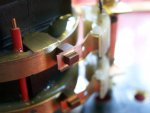Rog,
thanks for the kind welcome. Yes, it's been my only build so far. I am working part-time on a 7 laser assault rifle but the alignment of the beams into a 6mm perfectly parallel energy stream is giving me a real headache. The mirrors required to align the 7 lasers are ridiculously expensive and outside my means. Alker, the fiber optics people (they do all the fiber optics for the Eurofigher jet) are helping me with the problem and are trying to find the right optic for the nanometerage of the diode (532nm) and once they find a cable that will allow the transfer of the beam in a clearly visible stream once it leaves the end of the cable then I am up and running. A lot has to do with the last 100mm of the 7 optic cables being perfectly parallel and the finish of the 1.5mm cables end. It has to be lensed to a precise curveture or the beam will spread rather than remain collimated.
The sale of the Phaser will help to go towards development and component costs.
depth3d




